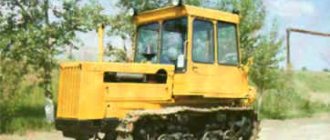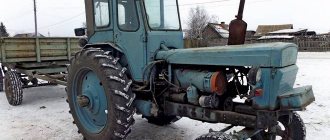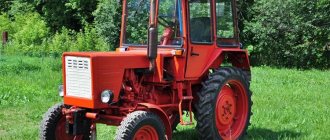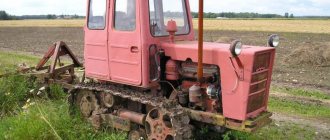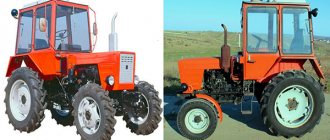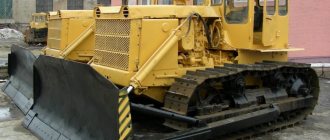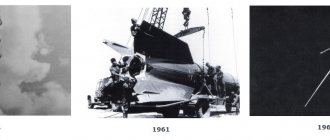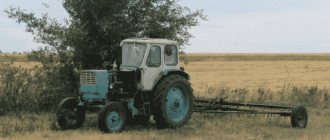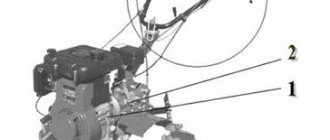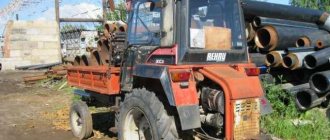The T-100/100M model tracked vehicle, which traces its origins to the Stalinets tractors, has been produced in Chelyabinsk since 1964. The characteristics of the T-100 tractor and the safety margin built into the design made it possible to carry out several upgrades. The descendants of the car lasted on the assembly line until 2002 under the designation T-130, and then T-170.
Development and release
The T-100 tractor, which received the short sonorous nickname “weaving” among users, is one of the most popular models of crawler tractors produced in Soviet times. The model was released between 1963 and 1983. Manufacturing plant: Chelyabinsk Tractor Plant. The prototype of the T-100 was the T108 tractor, which was produced in production under the name T100M.
Tractor T-100M
The device has a wide range of uses and can be combined with many types of additional equipment, for example, bulldozers, heavy-duty self-unloading trailers, cranes, rollers, and scrapers. The T-100 can also work with conventional agricultural equipment, such as a harrow, seeder, potato digger, etc.
Bulldozer device
The T-100 tractor has a classic bulldozer assembly. Its engine is located at the front of the car. This engine arrangement is considered classic. Moreover, most of the mass falls on the front part of the tractor, and the cooling system is simpler. The transmission is also located in the front.
The T-100 was equipped with the D-108 engine. This four-cylinder engine had an integral combustion chamber, a vertical cylinder arrangement and a gear fuel pump with a centrifugal regulator.
Purpose of the T-100 tractor
The main area of application of the T-100 tractor planned by the developers was to work in combination with the D3-53 bulldozer, but later the equipment for the bulldozer was modified with a hydraulic system. A lot of additional equipment was produced for the D3-54 bulldozer model (a more advanced version that followed the D3-53), for example, a brush cutter, a device for uprooting stumps from the ground, a stone remover, a soil loosener, soil dredgers and more.
Tractor T-100
The T-100 tractor also served as a pipe layer and, in some cases, a crane. Thus, the purpose of the tractor was more industrial than domestic. For planting and collective farm work at that time, lighter, more maneuverable models were used, the control of which could be mastered by any person. Thanks to its heavy weight of 11,100 kg. The equipment was used in forestry work, construction, and industrial enterprises.
Creating a model
The industrial Soviet tractor, like many other types of equipment in those days, named after I.V. Stalin S-100, underwent major changes in the early 60s of the 20th century. First, the T-108 modification appeared. It was released for only three years. In 1964, the plant began producing “weaving”. And just four years later, the T-100 tractor won a gold medal at an international exhibition.
The heavy tracked vehicle was intended for industry and construction work. It was designed as a bulldozer with a rope-controlled blade. Later, it was decided to modernize it to use a variety of attachments. Unlike its predecessor, which had only two modifications, fourteen types of special equipment were produced based on the tracked T-100.
“Sotka”, as an industrial tractor, belonged to traction class 10. By the way, the modern wheeled T-25 (100% universal tractor, as it is proudly called) belongs to traction class 0.6. This category is determined by the maximum force that, under certain strictly established conditions, a wheeled or tracked vehicle can develop.
Model range and modifications of T100
The level of technical capabilities of the T100 tractor allowed the manufacturer to release 22 modifications based on the flagship model. The model range included the following types of equipment, which later became popular:
- T-100M - the model, which is officially called the basic one, did not have hydraulic equipment and was not designed for the installation of rear-type hitches;
- T100MGS - with hydraulic equipment and rear equipment mounting system, PTO shaft, main purpose - agricultural;
- T100MGP - with gyro equipment and a front linkage system, there is a rigid coupling, a PTO shaft, the main purpose is industrial;
- T100MB - main purpose - swamp, the total area of the caterpillar track has been increased;
- T100MBG - swamp version of T100MGP;
- T100T - main purpose - work with a pipe layer (no mounted systems);
- T-100МГП-1 - lightweight hood, no cabin, modification of МГП100;
- T-100MZ - analogue of T130;
- T-100MZB - main purpose swamp, analogue of T130;
- T-100MZGP is the latest modification in the model range. It was equipped with hydraulics to simplify the turning process, making it easier to operate.
Fuel consumption
The fuel consumption of any equipment depends on the complexity of the work performed. The T-100 tractor is no exception. At average load, the machine uses no more than one liter of diesel fuel per hour of operation. The maximum flow rate is less than two liters per hour. Due to the rigid suspension, the tractor may experience many shocks during active work, but due to the relatively low speed, these shocks do not have much force.
D-108 engine fuel pump installation diagram
Specifications
Distinctive features of the T100 tractor are: a more powerful, improved engine with high torque, as well as an easy start function due to the presence of a P-23 engine. Some of the machines produced are still used in Russia, Belarus, and Ukraine. The cost of this model ranges from 150 to 300 thousand rubles (from 250 to 470 thousand hryvnia).
Weight and dimensions of T100
- The length of the T-100 is 4255 mm, height 3059 mm, width 2460 mm.
- The track created by the tractor is 1880 mm, ground clearance is 31.1 cm.
- Traction force at moderate speed is 6000 kg, in first gear - 9500 kg, in fifth gear 2000 kg.
- The higher the speed the car develops, the more the traction force decreases.
- The weight of the T-100 is 11,100 kg.
engine's type
- The engine brand of the T100 tractor is D108, diesel.
- Four-stroke, 4 cylinders, combustion chamber of an undivided type. The combustion chamber was located in the engine piston.
- The tractor power was 108 hp at a crankshaft speed of 1070 rpm.
- Cylinder volume 15.53 l.
- Engine weight - 2100 kg.
To make the diesel engine easy to start in the cold season, at sub-zero temperatures, engineers equipped the car with a P-23 engine powered by an electric starter.
The fuel tank capacity of the device is 235 l. The oil filter is equipped with a jet centrifuge. Starting the device has become easier due to a decrease in the fuel compression ratio. The torque was increased to 82 kgm.
Gearbox of the T-100 tractor
- mechanical;
- five forward gears, four reverse gears;
- three-way;
- reversible;
- bevel center gear;
- the drive gear is assembled into a block with the lower shaft;
- type of fastening of the driven gear - to the central gear shaft;
- rotary couplings are dry, multi-disc.
The speed range of the T-100 tractor was from 2 to 10 km/h when moving forward, from 2.8 to 7.6 km/h when moving backward.
Transmission and chassis
Clutch: dry, two driven discs. Clutch control mechanism: lever-cam. The clutch could be controlled from the driver's cabin using a lever.
Semi-rigid chassis. The chassis mechanism included tracked bogies (2 units), a balancer and the tracks themselves. The track chain was driven by a tension wheel and a special mechanism.
Cabin
At the time of the start of production (60s), the cabin of the T-100 tractor was one of the most comfortable among devices of similar purpose and traction class. The operator's soft seat, lighting, ventilation - all this made the work of the tractor operator comfortable. Contemporaries consider the air noise in the cabin caused by the forced ventilation system to be a minor drawback.
Control of the T-100 tractor
The tractor was braked using the onboard brakes. Turning was ensured by friction clutches and brakes. When driving the car, the driver felt quite a strong vibration, which was due to the type of suspension and the presence of a caterpillar track rather than wheels.
In agriculture, the model has not found wide use due to its low speed, but in industry, the “weaving” has gained recognition precisely because of its weight and smooth movement mode.
DT-90
An agricultural and construction crawler tractor, built on the basis of model 75. The full name of the machine is DT-90P. The tractor is equipped with an in-line 4-cylinder diesel engine D-440. The engine is equipped with a modified cylinder head adapted to install a turbocharger. The cooling system is liquid, with forced circulation and a thermostat. The engine develops a power of 95 hp, while providing a torque reserve of at least 35%.
The tractor uses a mechanical 7-speed gearbox equipped with a stern output of the power take-off shaft. As standard, the shaft has a rotation speed of 540 rpm. There are machines equipped with a shaft that provides a rotation speed of 1000 rpm. The plant produced such configurations on a separate order. The chassis consists of 4 road wheels, interlocked in pairs on bogies. The drive wheel is located at the rear, and a drive roller is installed at the front, which is used to tension the track.
The DT bulldozer is equipped with a blade, which is controlled by a hydraulic cylinder located in front of the radiator. The push bars are installed on an axle mounted on the tractor frame between the undercarriage bogies. The operation is controlled by the operator from the cabin, in which a hydraulic distributor is installed.
The DT-90P vehicles use a frame-type metal cabin. To install the cab on the chassis, rubber cushions are used to reduce vibration load. The equipment includes an air heater connected to the cooling system. In summer, the air in the cabin is cooled using an evaporative device installed in the ventilation system. The side walls are lined with soft material that absorbs sound and further reduces vibration.
Attachments
The most common type of attachment for a tractor of this model is a bulldozer blade. In addition to the blade, you can use the following types of mounted implements:
- winches;
- stump removers;
- swamp plow;
- trailed geyfer;
- harrow;
- hiller, ripper, cutter-cultivator;
- seeders;
- potato planters;
- dump trailers;
- excavator attachments;
- bucket loaders.
Bulldozer T-100. Stump remover
Running performance
The Soviet-made equipment in question has an advantage over its wheeled counterparts due to better maneuverability on soft soils. The specific indicator of “one hundred” is 4.6 N/kV. cm (ground pressure). It can be noted that the design of the T-100 is more complex in terms of chassis design, but more advantageous in other respects.
This unit consists of semi-rigid tracked carts equipped with balancing devices. The tracks were made in the form of a welded box-type frame, connected to each other by bushings and pins. The chassis was also equipped with shoes with a special profile, a chain with a tensioning mechanism, as well as support and safety rollers. The balancer type suspension is made in the form of a plate with springs.
Features of operation and maintenance
The T100 tractor must be operated according to universal rules (suitable for all crawler tractors):
- operate the equipment only while sitting in the operator’s seat;
- climb into the cabin only in the designated place, holding the handle near the cabin door and placing your foot on a special side platform;
- before starting work, make sure that there are no foreign objects in the tractor’s path of movement;
- to stop the device, use the brakes, first moving the gearshift lever to the neutral position, and only then engaging the brake;
- lower the implements after stopping the tractor;
- To maintain tracked mechanisms in proper condition, use special oil/grease;
- For operator safety, track tension is monitored visually, at a short distance from the tractor.
Oil or grease comes out of the release valve under high pressure and can cause injury if it comes into contact with the skin, so do not look at the release valve!!!
Maintenance of the T-100 caterpillar tractor is carried out according to the scheme:
- first service after 7 working hours (at the end of the shift);
- then after 120, 180, 240, 300, 360, 400 hours.
Actions performed by the operator during maintenance:
- clutch adjustment;
- adjusting the brake pedals;
- cleaning the outer surface of working units;
- replacing fuel filters;
- track adjustment (tension level).
When preserving a tractor for winter/seasonal storage, perform the following actions:
- drain the coolant;
- drain fuel sediment;
- all other fluids (from the windshield wiper reservoir, condensation from the air cylinder);
- move the control levers to neutral;
- turn off the battery;
- Place supports (beds) under the tractor so that the caterpillar part does not come into contact with the ground.
Links
Ivan Savvateevich Kavyarov (August 18, 1913, Makushino, now Kurgan region - July 14, 1980, Chelyabinsk) - Soviet design engineer, Doctor of Technical Sciences, professor. Participant of the Great Patriotic War, Guard Major.
T-100:
T-100 (tank) is an experimental Soviet double-turret heavy tank from the late 1930s.
T-100 is a complex installed on Product 64992: an experimental Soviet tank of the 1960s.
T-100 (tractor) - industrial tractor, produced by the Chelyabinsk Tractor Plant.
T-100 (tank destroyer) - Egyptian tank destroyer based on the T-34-85.
T-100 (teletype) is an electromechanical printing machine for sending and receiving text messages.
T-130 (T-10.01, tractor drivers often traditionally call the tractor T-100, or even S-100; colloquially - “weaving”) is a Soviet agricultural and industrial tracked tractor produced by the Chelyabinsk Tractor Plant. It is a deep modernization of the T-100 tractor. The tractor was produced in two modifications: conventional and swamp-moving (T-130B) with an increased track area.
The tractor is used as part of a bulldozer-ripper unit, and also as a base machine for a pipe layer and pile driver.
A further development of the T-130 tractor was the T-170 model, with its horsepower increased to 174. engine power.
There is an agricultural modification T-170MGS for plowing rice fields.
The tractor has 8 gears.
The T-130 and T-170 tractors deserve mixed reviews. Their advantages include simple design and low cost (compared to tractors of a similar class). At the same time, by the time mass production began, the tractor design, “rooted” in the 30s, was already seriously outdated. The mechanical transmission did not allow the engine to fully realize its power when working under high loads and complicated the process of controlling the tractor. The semi-rigid suspension also did not allow the tractor to realize the traction potential of the engine either through speed or traction. The service life of the onboard clutches, which have not undergone changes since the time of the S-80 tractor, in the T-130 tractor, and especially in the T-170, turned out to be extremely short. The diesel engine was started by an archaic starting four-stroke two-cylinder gasoline engine, which, in turn, was not so easy to start, especially in cold weather. The control levers and pedals, which acted directly on the transmission elements, vibrated strongly during operation. Tractors of a similar class, produced abroad in those years (USA, Japan), already had in their basic configuration a hydromechanical transmission, elastic suspension, a sprung sealed cabin, and remote control of the transmission and chassis, which eliminated the transmission of vibrations to the controls.
| Tractors of the USSR | |
| Wheeled vehicles for wide application |
|
| Wheeled universal |
|
| Crawler agricultural |
|
| Tracked industrial |
|
| Skidding |
|
| Army |
|
Basic faults and repairs
When operating the T-100 crawler tractor, the operator may encounter various malfunctions. The following list shows the most common problems and how to fix them:
- engine running intermittently (not warmed up, lack of fuel, clogged fuel line and filter - warm up the engine, check the fuel level, replace the filter, clean the fuel line);
- engine knock (valve clearance adjustment);
- smoky exhaust (bad fuel, water getting into the fuel, cold engine - warm up, replace fuel);
- increased oil consumption (the location of the piston rings is adjusted, oil leakage is eliminated);
- carburetor malfunctions (adjustment, debugging in progress);
- slipping of the clutch (it is necessary to wash the friction linings with kerosene);
- heating of the brake bands or the brake not working when pressed (repair: adjusting the brakes, washing the side clutches without turning them on).
